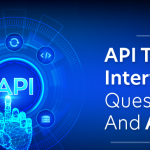React JS interview questions for senior developer: As the demand for React JS expertise continues to rise, senior developers must be well-prepared for interviews to showcase their proficiency and experience. In this comprehensive guide, we’ll explore the top 30 React JS interview questions, providing insights, explanations, and tips to help senior developers ace their interviews and secure coveted roles in the rapidly evolving world of front-end development.
ReactJS, commonly known as React, is a JavaScript library used for building user interfaces, particularly for creating interactive and dynamic web applications. Developed and maintained by Facebook, React allows developers to build reusable UI components, making it easier to manage and update complex user interfaces.
Key uses of ReactJS include:
- Component-Based Architecture: React promotes a component-based architecture, where the UI is broken down into modular and reusable components. This approach simplifies development, maintenance, and scalability.
- Virtual DOM: React uses a Virtual DOM (Document Object Model) to efficiently update and render components. This optimizes performance by minimizing direct manipulations to the actual DOM, resulting in faster rendering and improved user experience.
- Declarative Syntax: React uses a declarative syntax, making it easier to understand and debug code. Developers can describe how the UI should look based on the application state, and React takes care of updating the DOM accordingly.
- Efficient State Management: React provides a simple and efficient way to manage the state of an application. State management is crucial for handling dynamic data, user interactions, and ensuring a consistent UI.
- Reusability: React’s component-based structure allows developers to create reusable components, promoting code reusability and maintainability. This is particularly beneficial for large and complex applications.
- Unidirectional Data Flow: React follows a unidirectional data flow, meaning that data flows in a single direction within the application. This makes it easier to understand how changes in state or props affect the UI.
- Large Ecosystem: React has a vibrant ecosystem with a wide range of libraries, tools, and extensions that enhance its functionality. This includes state management libraries like Redux, routing with React Router, and development tools like React DevTools.
- Cross-Platform Development: While React is commonly used for web development, it can also be utilized for building mobile applications using frameworks like React Native. This allows developers to use their React skills for both web and mobile development.
Top 30 React JS interview questions for senior developer
1. What is React JS, and how does it differ from other JavaScript frameworks?
React JS is a JavaScript library for building user interfaces, primarily developed and maintained by Facebook. It excels in creating dynamic, efficient, and reusable UI components. Unlike traditional frameworks, React focuses on a component-based architecture, promoting a modular and maintainable codebase.
2. Explain the Virtual DOM in React and its significance.
The Virtual DOM is a lightweight copy of the actual DOM, maintained by React. It enhances performance by minimizing direct manipulations to the real DOM, updating only the changed elements. This optimizes rendering speed, resulting in a more responsive and efficient application.
3. What are React Components? How can you create them?
React Components are independent, reusable building blocks that encapsulate a part of the user interface. They can be either functional or class-based. Functional components are stateless and return JSX, while class components can manage state and lifecycle methods.
4. Describe the purpose of JSX in React.
JSX (JavaScript XML) is a syntax extension for JavaScript, used with React to describe what the UI should look like. It allows developers to write HTML-like code within JavaScript, making it more readable and expressive. JSX gets transformed into JavaScript during the compilation process.
5. What is the significance of state in React, and how is it different from props?
State in React is an object that represents the internal data of a component, allowing it to manage and maintain its own data. Props (short for properties) are passed from parent to child components and are immutable. While state is local and can be changed, props are read-only and provide a way for components to communicate.
6. Explain the React Lifecycle methods.
React Lifecycle methods are special methods that get executed at different points in a component’s lifecycle. Key methods include componentDidMount, shouldComponentUpdate, componentDidUpdate, and componentWillUnmount. They offer opportunities to perform actions at specific stages, like fetching data, updating the UI, or cleaning up resources.
7. How does React handle forms?
React manages forms by using controlled components, where form elements like input fields are controlled by React state. This allows React to have full control over the form’s values, making it easier to handle user input and update the UI accordingly.
8. Discuss the differences between controlled and uncontrolled components.
Controlled components have their state managed by React, making them more predictable and easier to integrate with React features like state and lifecycle methods. Uncontrolled components, on the other hand, store their state in the DOM, providing a more direct interaction with the browser but with less control.
9. What is React Router, and how does it work?
React Router is a standard library for routing in React applications. It enables navigation and rendering of components based on the URL. React Router provides a declarative approach to routing, allowing developers to define the navigation structure of their application.
10. Discuss the significance of keys in React.
Keys are special attributes in React used to uniquely identify and track elements in a list. They help React efficiently update and re-render components, particularly in dynamic lists where items can be added, removed, or rearranged.
11. What are Higher-Order Components (HOCs) in React?
Higher-Order Components are functions that take a component and return a new component with enhanced functionality. HOCs are a powerful pattern for code reuse, logic abstraction, and component composition in React applications.
12. Explain the concept of Redux and its role in React.
Redux is a state management library for JavaScript applications, commonly used with React. It centralizes the state of an application in a single store, making it more predictable and easier to manage. Actions, reducers, and the store are core concepts in Redux architecture.
13. How does React handle conditional rendering?
Conditional rendering in React involves dynamically displaying components or content based on specific conditions. This can be achieved using conditional statements, ternary operators, or logical && operators within JSX to determine what should be rendered.
14. Discuss the significance of the Context API in React.
The Context API in React provides a way to pass data through the component tree without having to pass props manually at every level. It simplifies state management in larger applications and helps avoid prop drilling.
15. What are Hooks in React, and how do they differ from class components?
Hooks are functions that allow functional components to use state and lifecycle features previously available only in class components. Key hooks include useState, useEffect, and useContext. They simplify component logic and encourage a more functional programming approach.
16. Explain the purpose of the useEffect hook in React.
The useEffect hook in React is used for side effects in functional components. It can perform actions like data fetching, subscriptions, or manually changing the DOM. useEffect runs after every render and can mimic lifecycle methods in class components.
17. Discuss the concept of React Fragments.
React Fragments are a lightweight way to group multiple elements without introducing additional nodes to the DOM. They improve code readability and structure by allowing developers to group elements without creating unnecessary parent elements.
18. How does error handling work in React?
Error handling in React involves using the componentDidCatch lifecycle method or the ErrorBoundary component to catch JavaScript errors that occur during rendering. This helps prevent the entire application from crashing and allows for graceful error handling.
19. What is the significance of PureComponent in React?
PureComponent is a class component in React that automatically implements the shouldComponentUpdate method with a shallow prop and state comparison. This optimization can improve performance by preventing unnecessary re-renders.
20. Explain the concept of code-splitting in React.
Code-splitting in React involves breaking down the bundle into smaller chunks, loading only the necessary code when needed. This optimization technique reduces the initial load time and improves application performance.
21. Discuss the benefits of Server-Side Rendering (SSR) in React applications.
Server-Side Rendering is a technique where the server sends fully rendered HTML pages to the client, enhancing performance and SEO. It ensures faster initial page loads and provides a better user experience.
22. What is React.memo, and how does it optimize functional components?
React.memo is a higher-order component that memoizes the result of a functional component, preventing unnecessary re-renders if the component’s props remain the same. This optimization can improve performance in certain scenarios.
23. Explain the concept of portals in React.
Portals in React provide a way to render children into a DOM node that exists outside the hierarchy of the parent component. This allows for more flexibility in rendering elements, particularly in situations where strict parent-child relationships are not suitable.
24. How can you optimize performance in React applications?
Performance optimization in React involves various techniques, including using PureComponent, memoization, code-splitting, proper state management, minimizing unnecessary renders, and implementing Server-Side Rendering (SSR) or Client-Side Rendering (CSR) based on the application’s requirements.
25. Discuss the challenges of managing state in large React applications and potential solutions.
Managing state in large React applications can become complex. Solutions include using state management libraries like Redux, adopting context for global state, and breaking down components into smaller, more manageable pieces.
26. What is the significance of the React DevTools extension?
React DevTools is a browser extension that allows developers to inspect and debug React components in the browser’s developer tools. It provides valuable insights into component hierarchies, state, and props, facilitating more effective development and debugging.
27. How does React handle security concerns, such as preventing Cross-Site Scripting (XSS) attacks?
React employs various security measures, including automatic escaping of content, preventing injection attacks, and promoting best practices for handling user input. Additionally, React’s Virtual DOM minimizes the risk of direct DOM manipulation leading to XSS vulnerabilities.
28. Discuss the concept of lazy loading in React.
Lazy loading involves loading components, modules, or assets only when they are needed, improving initial load times and optimizing performance. React supports lazy loading through the React.lazy() function and the Suspense component.
29. What are React Hooks Rules, and why are they essential?
React Hooks Rules are guidelines to follow when using hooks to ensure proper functionality and avoid common pitfalls. Adhering to these rules helps maintain a clean and predictable codebase, enhancing the overall quality of React applications.
30. How can you ensure the accessibility of a React application?
Ensuring accessibility in a React application involves using semantic HTML, providing meaningful text alternatives for images, implementing keyboard navigation, and adhering to accessibility standards. Integrating tools like aXe or eslint-plugin-jsx-a11y can help catch potential accessibility issues.
External Link
Conclusion
Mastering React JS requires a deep understanding of its core concepts, features, and best practices. By thoroughly preparing for these top 30 interview questions, senior developers can confidently demonstrate their expertise, stand out in interviews, and contribute effectively to building robust and scalable React applications. Stay curious, keep learning, and embrace the ever-evolving world of front-end development. Good luck on your React JS interview journey!









